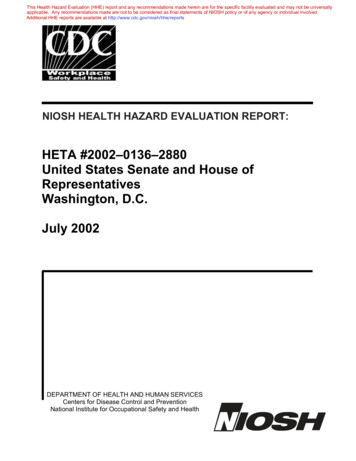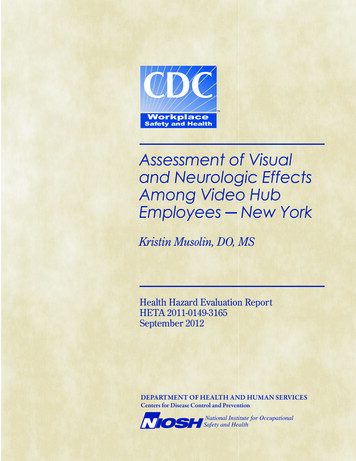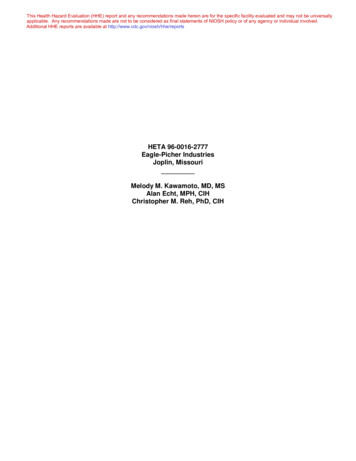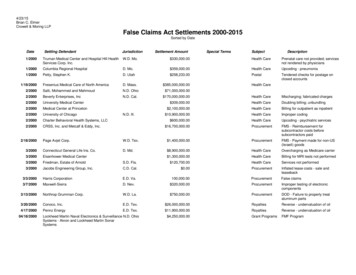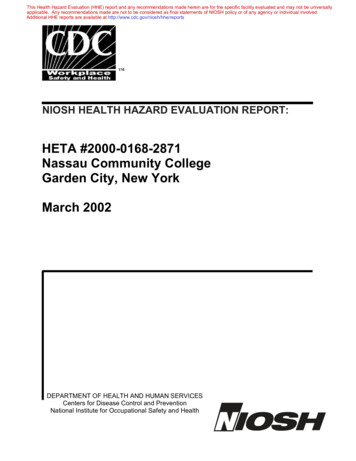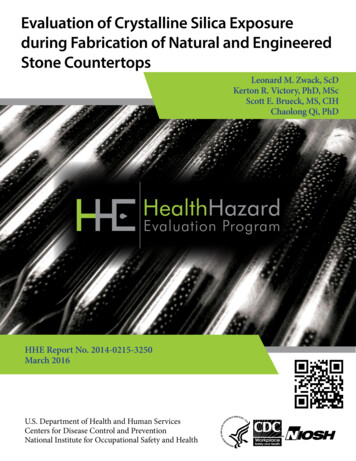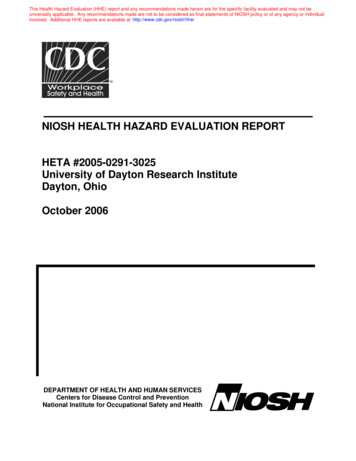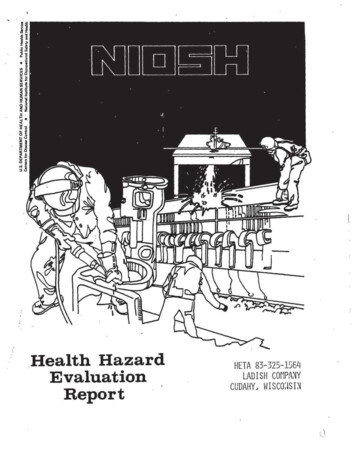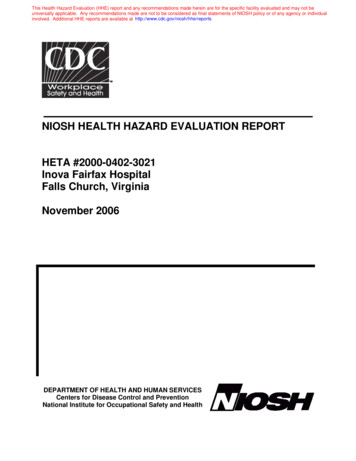
Transcription
This Health Hazard Evaluation (HHE) report and any recommendations made herein are for the specific facility evaluated and may not beuniversally applicable. Any recommendations made are not to be considered as final statements of NIOSH policy or of any agency or individualinvolved. Additional HHE reports are available at http://www.cdc.gov/niosh/hhe/reportsNIOSH HEALTH HAZARD EVALUATION REPORTHETA #2000-0402-3021Inova Fairfax HospitalFalls Church, VirginiaNovember 2006DEPARTMENT OF HEALTH AND HUMAN SERVICESCenters for Disease Control and PreventionNational Institute for Occupational Safety and Health
PREFACEThe Hazard Evaluation and Technical Assistance Branch (HETAB) of the National Institute forOccupational Safety and Health (NIOSH) conducts field investigations of possible health hazards in theworkplace. These investigations are conducted under the authority of Section 20(a)(6) of the OccupationalSafety and Health (OSHA) Act of 1970, 29 U.S.C. 669(a)(6) which authorizes the Secretary of Health andHuman Services, following a written request from any employers or authorized representative ofemployees, to determine whether any substance normally found in the place of employment haspotentially toxic effects in such concentrations as used or found.HETAB also provides, upon request, technical and consultative assistance to federal, state, and localagencies; labor; industry; and other groups or individuals to control occupational health hazards and toprevent related trauma and disease. Mention of company names or products does not constituteendorsement by NIOSH.ACKNOWLEDGMENTS AND AVAILABILITY OF REPORTThis report was prepared by Bradley King and Joel McCullough of HETAB, Division of Surveillance,Hazard Evaluations and Field Studies (DSHEFS). Field assistance was provided by Kristin Gwin and RobMcCleery. Analytical support was provided by DataChem Laboratories, Inc. (Salt Lake City, Utah).Desktop publishing was performed by Robin Smith. Editorial assistance was provided by Ellen Galloway.Copies of this report have been sent to employee and management representatives at Inova FairfaxHospital and the OSHA Regional Office. This report is not copyrighted and may be freely reproduced.The report may be viewed and printed from the following internet address:http://www.cdc.gov/niosh/hhe. Copies may be purchased from the National Technical InformationService (NTIS) at 5825 Port Royal Road, Springfield, Virginia 22161.For the purpose of informing affected employees, copies of this reportshall be posted by the employer in a prominent place accessible to theemployees for a period of 30 calendar days.ii
Highlights of Health Hazard EvaluationHighlights of the NIOSH Health Hazard EvaluationThe National Institute for Occupational Safety and Health (NIOSH) received a confidential employeerequest for a health hazard evaluation (HHE) at Inova Fairfax Hospital in Falls Church, Virginia. Thisrequest noted that employees had concerns regarding the health effects of exposure to byproducts ofsurgical smoke. These byproducts are produced during surgical operations where electrocautery knivesare used. NIOSH investigators conducted investigations in March and May 2001. What NIOSH Did We tested the air for chemicals commonlyfound in surgical smoke produced byelectrocautery knives during surgery.What Inova Fairfax Hospital ManagersCan DoWe asked employees about health symptomsthey feel are associated with exposures tothe surgical smoke. What NIOSH Found Of the compounds tested, formaldehyde,acetaldehyde, and toluene were found to bepresent in the air.Of the employees surveyed, 52% reported atleast one symptom that they associated withsurgical smoke exposure. Forty-two percent of employees describedirritation of their eyes and upper respiratorytract after surgical smoke exposure.Implement engineering controls duringprocedures where surgical smoke isproduced.Recommendedventilationtechniques include using local exhaustventilation as close as possible to the pointof smoke production, combined with generalroom ventilation.What the Inova Fairfax HospitalEmployees Can DoLevels of these compounds were below therelevant criteria for occupational exposure. Sixty-seven percent of employees reportedannoyance with the odor from the surgicalsmoke. Report instances of health symptomsthought to be associated with exposure tosurgicalsmoketothehospital’soccupational health staff.What To Do For More Information:We encourage you to read the full report. If youwould like a copy, either ask your health andsafety representative to make you a copy or call1-513-841-4252 and ask forHETA Report #2000-0402-3021iii
Health Hazard Evaluation Report 2000-0402-3021Inova Fairfax HospitalFalls Church, VirginiaNovember 2006Bradley King, MPH, CIHJoel McCullough, MD, MPHSUMMARYOn August 21, 2000, the National Institute for Occupational Safety and Health (NIOSH) received aconfidential employee request for a health hazard evaluation at Inova Fairfax Hospital in Falls Church,Virginia. The request noted concerns from surgery department employees in regard to exposure tocompounds found in surgical smoke and respiratory symptoms and headaches thought to be associatedwith such exposure.In March 2001, NIOSH investigators conducted a site visit to the facility and met with management andemployee representatives. A return site visit was made in May 2001. A questionnaire regardingsymptoms potentially associated with exposure to surgical smoke byproducts was distributed toemployees of the surgery department. Personal breathing zone and area air samples were collected during15 procedures over 3 days for compounds commonly found in surgical smoke plume. These substancesincluded volatile organic compounds (including benzene, toluene, and xylene), acrolein, phenol, cresols,hydrogen cyanide, formaldehyde, acetaldehyde, polycyclic aromatic compounds, and carbon monoxide.Although exposures to chemical compounds above the permitted or recommended limitswere not identified, low concentrations of compounds found in surgical smoke may besufficient to cause irritative effects on the eyes and mucous membranes, especially insensitive individuals. In fact, greater than half of employees surveyed associated at leastone symptom with exposure to surgical smoke and most employees surveyed found theodor associated with surgical smoke annoying and/or objectionable. Although not studiedin this evaluation, past NIOSH research has also shown the possibility of mutagenicairborne particulates being present in surgical smoke. The use of engineering controlssuch as a smoke evacuator is recommended to reduce the levels of surgical smoke in theoperating rooms.Keywords: SIC 8062 (General Medical and Surgical Hospitals), NAICS 622110 (General Medical andSurgical Hospitals), surgical smoke, laser, electrocautery, eye irritation, throat irritation, asthmasymptoms, hospitals, surgery, formaldehyde, acetaldehyde, toluene.iv
Table of ContentsPreface.iiAcknowledgments and Availability of Report.iiHighlights of Health Hazard Evaluation .iiiSummary.ivIntroduction. 1Background . 1Methods. 1Medical. 1Industrial Hygiene . 1Evaluation Criteria . 3Surgical Smoke. 4Volatile Organic Compounds. 4Benzene . 4Toluene. 5Xylene. 5Aldehydes. 5Formaldehyde. 5Acetaldehyde . 6Acrylaldehyde (Acrolein) . 6Polycyclic Aromatic Compounds. 6Cresols. 7Phenol. 7Hydrogen Cyanide . 7Carbon Monoxide . 7Particulates . 7Results . 8Medical. 8Industrial Hygiene . 8Discussion and Conclusions . 9Recommendations . 10References. 10
INTRODUCTIONOn August 21, 2000, the National Institute forOccupational Safety and Health (NIOSH)received a confidential employee request for ahealth hazard evaluation (HHE) at Inova FairfaxHospital in Falls Church, Virginia. The requestnoted concerns from surgery departmentemployees in regard to exposure to chemicalcompounds in surgical smoke as well as reportsof respiratory illness and headaches.On March 8-9, 2001, NIOSH medical andindustrial hygiene investigators visited thefacility to conduct an initial site visit. Anopening conference was held with managementand employee representatives to discuss therequest, and a walk-through of the facility wasconducted to gain an understanding of its layoutand procedures.On May 21-25, 2001, NIOSH investigatorsreturned to the facility and met withmanagement and employee representatives. Aquestionnaire regarding symptoms potentiallyassociated with exposure to surgical smokebyproducts was distributed to employees of thesurgery department. Personal breathing zone(PBZ) and area air samples were collectedduring 15 procedures over 3 days for compoundscommonly found in surgical smoke plume.These compounds include volatile organiccompounds (VOCs) (including benzene, toluene,and xylene), acrolein, phenol, cresols, hydrogencyanide, formaldehyde, acetaldehyde, polycyclicaromatic compounds, and carbon monoxide. Aninterim letter reporting the results from theindustrial hygiene sampling was mailed to InovaFairfax Hospital management and employeerepresentatives on December 14, 2001.Universities and the Medical College ofVirginia. Multiple operating room units exist atthe hospital. The NIOSH investigators focusedon a main surgical suite containing 14 operatingrooms (ORs), including two specifically forurology procedures.METHODSMedicalA one-page self-administered questionnaire wasdistributed to 50 OR personnel on the days ofthe return site visit by NIOSH investigators. Thequestionnairecontaineddemographicinformation, including job title and number ofyears working in an OR. The questionnaire alsoinquired about symptoms that occurred duringexposure to surgical smoke in the previous 4weeks. These symptoms included coughing,wheezing, shortness of breath, chest tightness,eye irritation, burning in nose or throat, nasalsymptoms, and headache. The questionnaireinquired if the respondent had ever beendiagnosed with asthma by a doctor and, if yes,when. The questionnaire also asked aboutannoyance caused by the odor of surgicalsmoke.Industrial HygieneBACKGROUNDOn the initial site visit, a walk-through of thefacility was conducted to gain an understandingof its layout and procedures. During the returnsite visit, PBZ and area air sampling for avariety of components commonly found insurgical smoke was performed. Over the 3-daysampling period, air samples were collectedduring 15 surgical procedures; all varied withrespect to type of procedure, length ofprocedure, and duration of use of theelectrocautery unit (i.e., amount of smokeproduction).Inova Fairfax Hospital is a 753-bed regionalmedical center in Falls Church, Virginia, servingthe Washington, DC metropolitan area. Thehospital is a medical and nursing teachinghospital affiliated with the medical schools ofGeorgetownandGeorgeWashingtonOn May 22, 2001, sampling was performedduring five procedures. These included amastectomy,acystoscopy-transurethralresection of the prostate (TURP), aprostatectomy, a body cast replacement forscoliosis, and a spinal fusion. On May 23, 2001,Health Hazard Evaluation Report No. 2000-0402-3021Page 1
five surgical procedures were sampled: a lumbardecompression, two lumbar laminectomies, abreast tissue expander insertion, and athyroidectomy. Four surgical procedures weresampled on May 24, 2001. These included acystoscopy-TURP, a small bowel resection, andtwo mastectomies.Qualitative area air sampling was performed inthe OR for identification of airborne VOCs. Athermal desorption tube containing differentsorbents for collecting a wide range ofcompounds was typically placed within severalfeet of the surgical table to collect an area airsample during each procedure. Tubingconnected the sampler, and a personal samplingpump allowed air to be drawn through thesampling train at a calibrated flow rate of 20milliliters per minute (mL/min). Analysis of thedesorption tubes for captured VOCs wasperformed according to the NIOSH Manual ofAnalytic Methods (NMAM) Method 2549 usinga Perkin-Elmer ATD 400 thermal desorptionsystem interfaced directly to a gaschromatograph with a mass selective detector(TD-GC-MSD).Area air sampling was performed for specificVOCs including toluene, benzene, and xyleneand a variety of compounds detected during thequalitative screening; samplers were typicallyplaced within several feet of the surgical table atan average shoulder height to collect the area airsamples during each procedure.Typicallyduring each procedure sampled, one individualat the surgical table (such as a scrub nurse) andone individual (such as a circulating nurse)stationed at the periphery of the room wore asampling pump to obtain a PBZ sample for theseVOCs. During the site visit, 14 area air samplesand 27 PBZ samples were collected. Thesesamples were collected using solid sorbent(coconut shell charcoal) tubes and pumpscalibrated to provide a volumetric flow rate of100 mL/min. Analysis of the samples wasconducted using a combination of the conditionsfrom the NIOSH Methods 2537, 1400, 3701,1300, 1550, 1501, 1500, and OSHA method103, with modifications. 1,2 The sorbent tubeswere analyzed using gas chromatography withPage 2flame ionization detection. The limits ofdetection (LOD) for these compounds were: 0.4micrograms (µg) benzene/sample, 0.4 µgtoluene/sample, 2 µg xylene/sample, and 4 µgtotal hydrocarbons/sample. The limits ofquantitation (LOQ) were 1 µg benzene/sample,1 µg toluene/sample, 8 µg xylene/sample, and10 µg total hydrocarbons/sample.In a similar fashion, PBZ and area air samplingwas performed for aldehydes, particularlyformaldehyde and acetaldehyde. Samples eated silica gel cartridges. Tubingconnected to the sampler and sampling pumpallowed air to be drawn at a calibrated flow rateof 100 mL/min. Twenty-five PBZ samples and14 area air samples were collected foraldehydes. Analysis of the cartridges wasperformed according to NIOSH Method 2016with modifications. The LODs were 0.02 e. The LOQs were 0.08 .Fourteen area air samples were collected foracrolein using XAD-2 solid sorbent tubesconnected to sampling pumps calibrated toprovide a volumetric flow rate of 100 mL/min.Analysis of the samples was conducted usinggas chromatography according to NIOSHMethod 2539 with modifications. The LOD foracrolein was 0.8 µg/sample; the LOQ was 3µg/sample.Fourteen area air samples were collected ethylene (PTFE) filters andXAD-2 solid sorbent tubes connected tosampling pumps calibrated to provide avolumetric flow rate of 100 mL/min. Analysis ofthe samples was conducted using fluorescencedetection according to NIOSH Method 5800.The LOD and LOQ were 3 µg/sample and 10µg/sample, respectively.Fourteen area air samples were collected forcresols and phenol using XAD-7 solid sorbenttubes connected to sampling pumps calibrated toHealth Hazard Evaluation Report No. 2000-0402-3021
provide a volumetric flow rate of 100 mL/min.Analysis of the samples was conducted usinggas chromatography with flame ionizationdetection according to NIOSH Method 2546.The LODs were 1 µg cresols/sample and 0.8 µgphenol/sample. The LOQs were 4 µgcresols/sample and 3 µg phenol/sample.Fourteen area air samples were collected forhydrogen cyanide using soda lime solid sorbenttubes connected to sampling pumps calibrated toprovide a volumetric flow rate of 100 mL/min.Analysis of the samples was conducted usingspectrophotometry according to NIOSH Method6010 with modifications. The LODs and LOQwere 0.2 µg/sample and 0.7 µg/sample,respectively.Area air sampling was performed according toNMAM Method 6604 for carbon monoxide(CO) using the Biosystems Inc. ToxiUltra GasDetector, a passive diffusion monitor, whichrecorded CO concentrations during eachprocedure. One reading was taken every 30seconds by each monitor. The recordedmeasurements were then downloaded to acomputer. The monitor measures COconcentrations from 0-500 parts per million(ppm), and had been calibrated prior to the sitevisit according to the manufacturer’sspecifications.A Grimm Model 1108 real-time Dust Monitor(Grimm Technologies Inc., Douglasville, GA)was used to perform real-time area sampling forthe levels of airborne particulates in theoperating room environment during varioussurgical procedures. The Grimm Dust Monitor isa light-scattering aerosol spectrometer designedfor real-time particulate measurement withparticle size discrimination. Data was collectedover the entire time period during the selectedprocedures. For each, the data was integrated for1 minute and stored sequentially on the Grimmdata card over the entire sampling period. Thecollected information was downloaded to alaptop computer following the completion of thesampling day.EVALUATION CRITERIAAs a guide to the evaluation of the hazards posedby workplace exposures, NIOSH field staffemploy environmental evaluation criteria for theassessment of a number of chemical andphysical agents. These criteria are intended tosuggest levels of exposure to which mostworkers may be exposed up to 10 hours per day,40 hours per week for a working lifetimewithout experiencing adverse health effects. Itis, however, important to note that not allworkers will be protected from adverse healtheffects even though their exposures aremaintained below these levels. A smallpercentage may experience adverse healtheffects because of individual susceptibility, apre-existing medical condition, and/or ahypersensitivity (allergy). In addition, somehazardous substances may act in combinationwith other workplace exposures, the generalenvironment, or with medications or personalhabits of the worker to produce health effectseven if the occupational exposures are controlledat the level set by the criterion. These combinedeffects are often not considered in the evaluationcriteria. Also, some substances are absorbed bydirect contact with the skin and mucousmembranes, and thus potentially increase theoverall exposure. Finally, evaluation criteriamay change over the years as new informationon the toxic effects of an agent becomeavailable.The primary sources of environmentalevaluation criteria for the workplace are: (1)NIOSH Recommended Exposure Limits(RELs), 3 (2) the American Conference ofGovernmental Industrial Hygienists’ (ACGIH )Threshold Limit Values (TLVs ), 4 and (3) theU.S. Department of Labor, Occupational Safetyand Health Administration (OSHA) PermissibleExposure Limits (PELs). 5 Employers areencouraged to follow the OSHA limits, theNIOSH RELs, the ACGIH TLVs, or whicheverare the more protective criteria.OSHA requires an employer to furnishemployees a place of employment that is freefrom recognized hazards that are causing or areHealth Hazard Evaluation Report No. 2000-0402-3021Page 3
likely to cause death or serious physical harm[Occupational Safety and Health Act of 1970,Public Law 91–596, sec. 5(a)(1)]. Thus,employers should understand that not allhazardous chemicals have specific OSHAexposure limits such as PELs and short-termexposure limits (STELs). An employer is stillrequired by OSHA to protect their employeesfrom hazards, even in the absence of a specificOSHA PEL.All personnel who work in ORs are exposed tosurgical smoke to some degree, but the extent ofthe exposure can be highly variable. Surgeonsand others standing at the operating tablegenerally have a more concentrated exposure tosmoke during procedures, but scrub nurses,circulating nurses, and surgical technicians mayalso have exposures. Surgical smoke is knownto produce odors and limit the view of thesurgical field.A time-weighted average (TWA) exposurerefers to the average airborne concentration of asubstance during a normal 8- to 10-hourworkday. Some substances have recommendedSTEL or ceiling values which are intended tosupplement the TWA where there arerecognized toxic effects from higher exposuresover the short-term.Surgical smoke has potential biological andchemical components. Viable bacteria havebeen cultured from surgical smoke. Thesebacteria include Bacillus subtillis andStaphylococcus aureus. Mycobacteria have rculosis. 7Humanimmunodeficiency virus (HIV) proviral DNAand intact viral DNA from the human papillomavirus have been found in plumes produced bylasers. 8,9 Other biological materials collectedfrom surgical smoke include intact andfragmented human cells and intact DNA. 10,11 Inaddition to biological material, chemical byproducts have also been found in the surgicalsmoke, including various volatile organiccompounds, polycyclic aromatic compounds,aldehydes, cresols, phenol, hydrogen cyanide,and carbon monoxide.Surgical SmokeSurgical smoke or plume is created when energyis delivered to intact cells during surgery. Whenenergy from a laser or electrosurgical unit isdelivered to a cell, energy in the form of heat isreleased. This heat vaporizes the intracellularfluid, increasing the pressure inside the cell, andeventually causing rupture of the cell membrane.After the membrane bursts, a plume of smoke isreleased into the atmosphere of the OR. At thesame time, the intense heat chars the protein andother organic material within the cell and causesthermal death of the adjacent cells. The charringof cells releases material such as carbonized cellfragments and hydrocarbons. 6Compared to electrosurgery, thermal lasersvaporize tissue very rapidly, causing anexplosive effect. This explosive tissue responsecauses rapid generation of odors and thickplumes of smoke. Electrosurgical energy causeshemostasis and dissection more slowly, and thetissue response is not as explosive. The amountof surgical smoke may vary with: (1) the type ofsurgical procedure, (2) the target tissue, (3)surgical technique, (4) duration of application ofthermal or mechanical energy, and (5) theinstrument used to vaporize the tissue.Page 4Volatile Organic CompoundsVolatile organic compounds (VOCs) describe alarge class of chemicals that are organic (i.e.,contain carbon) and have a sufficiently highvapor pressure to allow some of the compoundto exist in the gaseous state at room temperature.These compounds are emitted in varyingconcentrations from numerous indoor sourcesincluding, but not limited to, carpeting, fabrics,adhesives, solvents, paints, cleaners, waxes,cigarettes, and combustion sources.BenzeneBenzene is an aromatic organic hydrocarboncontaining a six-carbon ring with alternatingdouble bonds. Acute inhalation exposure to highconcentrations of benzene can cause drowsiness,fatigue, nausea, vertigo, narcosis, and othersymptoms of central nervous system (CNS)Health Hazard Evaluation Report No. 2000-0402-3021
depression as noted with excessive exposure toother aromatic hydrocarbons.4, 12 , 13 However, themost remarkable health effects associated withbenzene exposure are chronic effects due torepeated exposure to low concentrations overmany years.Benzene is classified by the InternationalAgency for Research on Cancer (IARC) as aknown human carcinogen and has beenassociated with irreversible bone marrow injuryand the development of hematopoietic toxicity,including aplastic anemia and leukemia inhumans. 14, 15 NIOSH classifies benzene as ahuman carcinogen, and recommends controllingoccupational exposures to prevent employeesfrom being exposed to concentrations greaterthan 0.1 ppm, determined as a TWAconcentration for up to a 10-hour work shift in a40-hourworkweek.NIOSHfurtherrecommends a 15-minute STEL of 1.0 ppm.Although NIOSH has established theseguidelines which should not be exceeded, theInstitute still urges reducing exposures to the"lowest feasible concentration" because it is notpossible to establish thresholds for carcinogensthat will protect 100% of the population. Thecurrent ACGIH TLV is 0.5 ppm for an 8-hourTWA with a 15-minute STEL of 2.5 ppm, and isnoted as a confirmed human carcinogen. TheOSHA PEL is 1 ppm for an 8-hour TWA with a15-minute STEL of 5 ppm. 16TolueneToluene is a colorless, aromatic organic liquidcontaining a six-carbon ring (a benzene ring)with a methyl group (CH3) substitution.Inhalation and skin absorption are the majoroccupational routes of entry. Toluene can causeacute irritation of the eyes, respiratory tract, andskin. 17The main effects reported with excessive(inhalation) exposure to toluene are CNSdepression and neurotoxicity. Studies haveshown that subjects exposed to 100 ppm oftoluene for 6 hours complained of eye and noseirritation, and in some cases, headache,dizziness, and a feeling of intoxicationHealth Hazard Evaluation Report No. 2000-0402-3021(narcosis). 18, 19 , 20 No symptoms were notedbelow 100 ppm in these studies.The NIOSH REL for toluene is 100 ppm for upto a 10-hour TWA. NIOSH has also set arecommended STEL of 150 ppm for a 15-minutesampling period. The ACGIH TLV is 50 ppmfor an 8-hour TWA, with a Notice of IntendedChanges to 20 ppm. The OSHA PEL for tolueneis 200 ppm for an 8-hour TWA.XyleneXylene is a colorless, flammable organic liquidwith a molecular structure consisting of abenzene ring with two methyl group (CH3)substitutions. The vapor of xylene has irritanteffects on the skin and mucous membranes,including the eyes and respiratory tract. Thisirritation may cause itching, redness,inflammation, and discomfort.Acute xylene inhalation exposure may causeheadache, dizziness, uncoordination, drowsiness,and unconsciousness. 21 Previous studies haveshown that concentrations from 60 to 350 ppmmay cause giddiness, anorexia, and vomiting. Athigh concentrations, exposure to xylene has anarcotic effect on the CNS, and minor reversibleeffects on the liver and kidneys.21,22The current OSHA PEL, NIOSH REL, andACGIH TLV for xylene are 100 ppm over an 810 hour TWA.3,4,5 In addition, OSH
Inova Fairfax Hospital Falls Church, Virginia November 2006 Bradley King, MPH, CIH Joel McCullough, MD, MPH SUMMARY On August 21, 2000, the National Institute for Occupational Safety and Health (NIOSH) received a confidential employee request for a health hazard evaluation at Inova Fairfax Hospital in Falls Church, Virginia.
